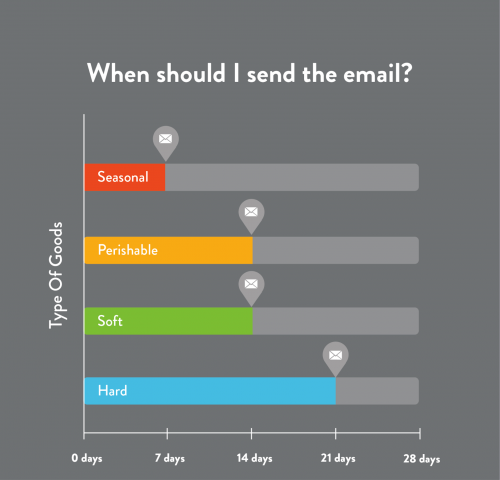We’ve passed the holidays. Hopefully the many customers you made are more than happy with whatever it is they purchased from you.
Now is a nice time to ask for a review.
But that begs the question — when should merchants send post-purchase emails for feedback and solicited reviews? According to PowerReviews, it depends mostly on the product you’ve sold, but it shouldn’t be immediately after the customer receives the product.
Segmenting products by quality, they found that the longer the lifespan of the good, the longer it should take before a review request is sent their way. For instance, if it’s a seasonal good that’s tied to a limited timeframe, an email needs to be sent sooner. If it’s a hard good meant for longterm use — something like an electronic accessory or tool — you’ll need to give them time to experience the product consistently before asking for them to write a review.
It’s Time to Solicit
To get a customer to write a review, you have no choice but to ask them — unless they’re amazing enough to do it themselves (so long as it’s positive). But it’s often how you ask the customer that often determines whether you’re successful.
Hunt Down Your Top Brass
First, play it safe. All e-retailers should get to know their top-buying customers and those that are enthusiastic about the brand. These are the guys and gals who write glowing reviews about your business that shine a positive light on your brand.
Send out some personalized emails to these individuals asking them to review a recent purchase. Maybe throw them a deal or discount after to thank them for their patronage (careful about doing that before, though, for reasons we’ll get to later).
To take it a step further, you can send out a generic blast requesting a review to all recent consumers. Or you can segment.
Generally when emailing, it’s a good idea to segment for more focused, targeted results. But before asking for a full-on review, you may want to ask for a rating. Segment your email list by product or product category to get an idea of each’s performance and how satisfied customers are with them. Or, choose a date range to see how consumers are feeling about a product XYZ amount of time later if it’s like one of those hard goods or seasonal items mentioned earlier.
Once customers drop a rating, you at least get an internal idea of what’s going well and what isn’t. Plus, you can now find the customers with 5 stars and send them a more personalized request for an in-depth review.
Drop Them a Call
It’s uncommon and it can make both parties uncomfortable, but it has potential: call your customer instead of blasting an email.
It doesn’t need to be a call that bluntly asks the customer for a review. Launch a conversation with your customer to see if they’re satisfied with their purchase, and, if they seem enthusiastic enough, ask them for a review. Do they seem “meh” about it? Leave it as a friendly phone call rather than a solicitation.
Dangle an Incentive
Nothing beats a deal, and, as most merchants are aware of, consumers will at times jump through hoops for one. It’s definitely possible to send out emails to recent customers offering a discount in return for a review.
That said, these methods are trickier and more gray. Because these are incentivized, they’ve got a whole host of issues with them. The mere fact that they’re done in exchange for something automatically applies a positive bias. You may be fine with that, but it can be bad PR and damage trust if consumers find out.
Just ask Amazon. After years of accusations of biased and one-sided reviews, the marketplace recently cracked down on those that are incentivized — they’ve banned any reviews that’s incentivized by discounts or free goods.
Use incentives at your own discretion. Or, as mentioned earlier, offer the discount or treat to customers that’ve written reviews without being incentivized as a thank you.
Returns
There are reviews about products themselves and then there are reviews about the total purchasing experience. And something unfortunate can occur at the end of that experience: returns.
Perhaps the best opportunity for soliciting a review is when you’re interacting with a specific customer to fix a return — preferably after they’ve had a positive experience. Although a return is an indication that something went wrong in the purchase process, it’s also a chance for the customer to rave about your support, which assists in getting potential customers to trust you enough to take the plunge and purchase.
Turning Around Negative Reviews
Flat out, online reviews matter. They’re social proof, they help build trust between you and potential customers, and they validate you. And for all those reasons, bad ones can accomplish the opposite.
Reviews bashing your business for malicious, shady, or poor service and product do need to be eradicated, especially if they’re unfair or the result of a misunderstanding. Plus, they’re also an opportunity to earn a positive review (or, down the line, a purchase).
Once one appears and you decide it’s important to change, here’s a solid way of going about remedying it:
- Make contact — reach out to them after the review is placed
- Listen — ask and listen to their account of what went wrong
- Apologize — sincerely say you’re sorry, even if the customer seems irrational or misguided
- Fix it — offer them a remedy or solution to smooth over what went wrong or ask the customer what they’d like if you can’t come up with one
- Prevent it — if the issue is preventable and isn’t an outlier, out-there type of discrepancy, work to eliminate the chance of it reoccurring
It’s little different than managing returns. All it takes a little communication to iron out what went wrong and repair your relationship. If your experience with them seemed positive enough, ask them to modify their negative review. That doesn’t mean it needs to be a total 180 — their existing issue can remain in the review, but a blurb mentioning how you both worked it out will work wonders on your image.
On the Other Hand
However, some of those lower scoring reviews are useful. For starters, many consumers are looking for a healthy balance of reviews because they want a glimpse at the pros and cons of purchasing from you — 82% of consumers actually seek out those negative ones. A perfect score often appears too good to be true, and, according to certain studies, most consumers tend to be most influenced by ratings between 4.2 and 4.5 rather than five stars.
Those low reviews can also do more than just balance out your overall rating. One to three star reviews can provide context to a potential customer that might not be a right fit for the product.
For instance, take The Godfather Coppola Restoration series in blu-ray. Usually when we think blu-ray, you think crazy high-def, right? Well, these are blu-ray, but they’re Coppola Restoration — the movies appear as if they were premiering in 1972 (not high-def at all). Those one-to-three star reviews expressing how they’re disappointed or feel misled are a useful red flag to ward off what would otherwise be an inevitable return.
What’s in a Star
Some low reviews aren’t worth the time trying to fix. We’ve all seen those Amazon reviews. Before buying we check the low stars, and many of them are blatantly vague, with phrases like “it broke” or “poor quality.” Reviews — or really a lack of review — like that don’t have much sway and they’ll likely be glossed over by consumers, helping focus their attention on in-depth and — ideally — positive reviews.
Speaking of ratings, those slightly less than perfect ratings can carry more weight than you’d think. Four star reviews can be a blessing — they provide more credibility to your reviews (again, a bunch of straight fives gets a little questionable) and they tend to be more balanced, better informing potential customers.




